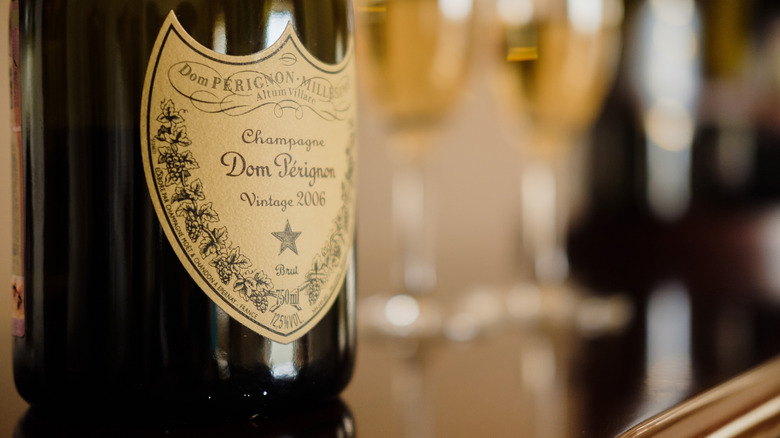The Main Difference Between Vintage And Non-Vintage Champagne
You probably already know that Champagne can only be called "champagne" if it comes from the Champagne region of France — that is, the grapes have to be grown in the region and made into wine, adhering to strict rules for winemaking. It's such a well-known fact that the internet has meme'd it hundreds of times.
Champagne itself is not a rare commodity. However, not all Champagne is created equal. In fact, the majority of the sparklers we pop to celebrate special events and ring in the New Year are nonvintage (NV), which are made from a blend of multiple wines that can be made in different years. Vintage Champagne, on the other hand, is made with fruit from select years when the grapes can ripen perfectly. Not every year is good enough to be considered a vintage year, and the wine needs to be aged before it's released for sale, so vintage Champagne is in much shorter supply. These factors combined can make a bottle of bubbly from a highly regarded vintage like Pérignon extremely unique — with a high price tag. So not only can it not be called Champagne unless it's made in Champagne, but it's important to know that you also can't call it "vintage" Champagne unless it was made with grapes grown in a single, perfect calendar year.
A vintage year is considered exceptional
Winemakers in Champagne make wine every year, of course. Non-vintage and vintage champagnes go through the same growing and winemaking processes and are made from the same varieties of legally approved grapes. Still, depending on the growing year, the resulting wines can vary significantly in taste, structure, and age-ability. Nature is unpredictable, and vineyards are often affected by frost, excessive heat, and too much or too little rain. It's actually not very often that growers get a perfect season where grapes can ripen without stress or damage, but when they do, that's when the producers will declare a vintage year because the fruit is exceptional. This typically only happens two or three times a decade, and there is considerable concern that climate change will make vintage years even more infrequent.
Since vintage years produce the best fruit, they also produce the best wines, which will have the right balance of structure and flavor to stand up to long periods of aging. So you can be forgiven if you thought that the term "vintage Champagne" meant that the wine is old because you're not entirely off base. In fact, by law, vintage Champagne must be aged for at least three years before it's released for sale, and many producers will age them even longer. Non-vintage wines from growing seasons don't age quite as well, however, and are only aged for 15 months in the bottle before they're released.
Non-vintage Champagnes are blended into a house style
Despite the appeal of vintage Champagne, most of the wine produced in France's famed winemaking region is nonvintage. More than 90% of the Champagne on the market is NV and is typically made from three to five different wines from different growing years (and sometimes even more) blended to create a house style that tastes the same year after year. This is part of the appeal of NV wines because you will always know what to expect when you open a bottle, and many people have favorite producers based on that house style or trademark flavor. Some of the most recognizable high-quality Champagnes on the market are NV, including bottles from Veuve Clicquot and Moët & Chandon.
Vintage Champagnes, in contrast, have unique flavors and aromas because each bottle is a unique expression of the vineyard and winery where it was made. You don't need to be a master sommelier with knowledge of vintage charts to know the difference between vintage and non-vintage; just read the label. A vintage bottle of Champagne will always have the date printed right on the front (even the extra-large format bottles that take three people to pour). So, among the list of mistakes you can make when drinking Champagne, at the very least, you'll know the difference between vintage and non-vintage bottles.


